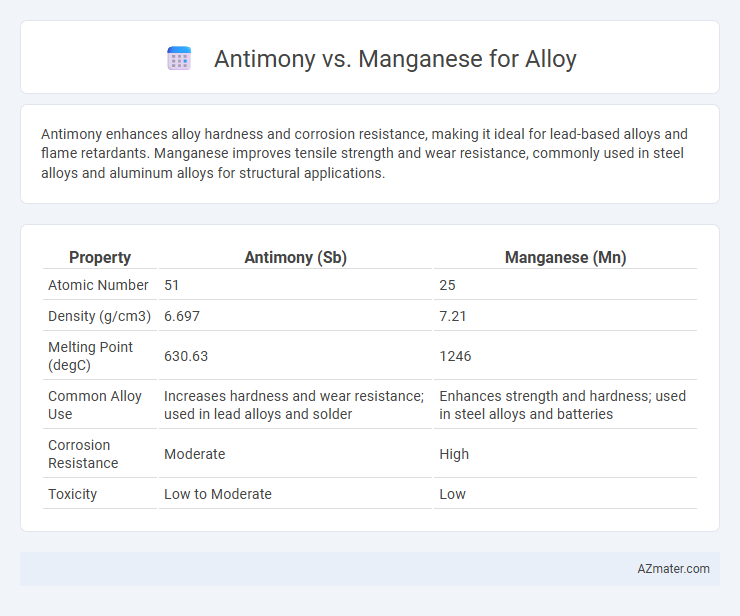Antimony enhances alloy hardness and corrosion resistance, making it ideal for lead-based alloys and flame retardants. Manganese improves tensile strength and wear resistance, commonly used in steel alloys and aluminum alloys for structural applications.
Table of Comparison
| Property | Antimony (Sb) | Manganese (Mn) |
|---|---|---|
| Atomic Number | 51 | 25 |
| Density (g/cm3) | 6.697 | 7.21 |
| Melting Point (degC) | 630.63 | 1246 |
| Common Alloy Use | Increases hardness and wear resistance; used in lead alloys and solder | Enhances strength and hardness; used in steel alloys and batteries |
| Corrosion Resistance | Moderate | High |
| Toxicity | Low to Moderate | Low |
Introduction to Antimony and Manganese in Alloy Formation
Antimony and manganese serve distinct roles in alloy formation, with antimony primarily enhancing hardness and corrosion resistance in lead and tin alloys, while manganese improves strength, toughness, and wear resistance in steel alloys. Antimony's ability to refine grain structure and increase metal density makes it valuable in applications requiring enhanced durability and stability. Manganese acts as a deoxidizer and alloying element, crucial for improving the mechanical properties and hardenability of steel used in construction and manufacturing.
Chemical Properties: Antimony vs Manganese
Antimony exhibits a stiff, brittle metalloid nature with a melting point of 630.6degC and corrodes slowly, making it suitable for enhancing hardness and corrosion resistance in alloys. Manganese, a transition metal with a melting point of 1244degC, offers strong oxidation resistance and excellent deoxidizing properties that improve tensile strength and wear resistance in steel alloys. The chemical distinctiveness between antimony's semimetal characteristics and manganese's active metallic behavior influences their specific alloying effects, favoring antimony for rigidity and manganese for strength and durability.
Alloying Behavior and Mechanisms
Antimony and manganese exhibit distinct alloying behaviors due to their atomic structures and chemical properties, with antimony acting primarily as a grain refiner and deoxidizer in alloys, while manganese enhances strength and wear resistance by forming stable carbides and improving hardenability. Antimony's limited solubility in most metals leads to segregation at grain boundaries, influencing mechanical properties through embrittlement or improved creep resistance depending on concentration and alloy system. Manganese promotes solid solution strengthening and acts as a scavenger for sulfur and oxygen, thereby improving toughness and corrosion resistance in steel-based alloys through the formation of manganese sulfides and oxide inclusions.
Common Alloy Types and Applications
Antimony is commonly alloyed with lead to improve hardness and mechanical strength in applications such as batteries, ammunition, and type metal, while manganese is primarily used in steel alloys to enhance toughness, wear resistance, and hardness in construction, automotive, and machinery components. Common antimony alloys include lead-antimony alloys used in lead-acid batteries and bearing metals, whereas common manganese alloys include high-manganese steel (Hadfield steel) known for impact resistance and steel-manganese-carbon alloys used in rails and heavy-duty parts. The choice between antimony and manganese in alloys depends on desired properties like corrosion resistance, hardness, and wear durability tailored to specific industrial demands.
Mechanical Properties Comparison
Antimony enhances alloy hardness and wear resistance by improving corrosion resistance and thermal stability, making it ideal for improving cast metals and lead alloys. Manganese significantly boosts tensile strength and toughness through grain refinement, offering excellent impact resistance and fatigue strength in steel alloys. Comparing mechanical properties, manganese alloys generally provide higher ductility and yield strength, while antimony alloys excel in hardness and dimensional stability under thermal stress.
Corrosion Resistance: Antimony vs Manganese Alloys
Antimony alloys exhibit superior corrosion resistance compared to manganese alloys, making them ideal for harsh chemical environments and high-temperature applications. Manganese alloys tend to be more prone to oxidation and corrosion, especially in acidic or saline conditions, limiting their effectiveness in long-term exposure scenarios. The choice between antimony and manganese in alloy compositions depends on the required durability against environmental degradation and specific industry needs for corrosion-resistant materials.
Cost and Availability of Alloy Components
Antimony is generally more expensive and less abundant than manganese, influencing alloy production costs and sourcing strategies. Manganese, being widely available and cost-effective, is preferred for large-scale alloy manufacturing, especially in steel production. Cost efficiency and supply reliability make manganese a crucial alloy component compared to the pricier and scarcer antimony.
Environmental and Health Considerations
Antimony in alloys presents environmental concerns due to its toxicity and potential to cause respiratory issues during processing and disposal, requiring strict handling and waste management protocols. Manganese, while essential in small amounts for human health, becomes neurotoxic at elevated exposures, particularly affecting workers in alloy production through inhalation of dust or fumes. Both elements demand rigorous occupational safety measures and environmental regulations to mitigate their adverse health effects and ecological impact in alloy manufacturing.
Suitability in Industrial Applications
Antimony enhances alloy hardness, corrosion resistance, and flame retardancy, making it ideal for lead-based alloys in batteries, bullets, and cable sheathing. Manganese improves tensile strength, toughness, and wear resistance, widely used in steel production and aluminum alloys for construction and automotive applications. Choosing between antimony and manganese depends on specific industrial requirements such as hardness versus strength and resistance to environmental factors.
Future Trends in Alloy Development
Antimony and manganese play distinct roles in alloy development, with manganese increasingly favored for its ability to improve strength and wear resistance in steel alloys, aligning with future trends toward high-performance, lightweight materials. Emerging research highlights manganese's potential in creating sustainable alloys due to its abundance and recyclability compared to antimony, which faces supply chain and toxicity challenges. Future alloy innovation emphasizes manganese's integration in advanced high-strength steels (AHSS) and battery technologies, while antimony remains more niche, primarily in flame retardants and specialized lead alloys.

Infographic: Antimony vs Manganese for Alloy
 azmater.com
azmater.com